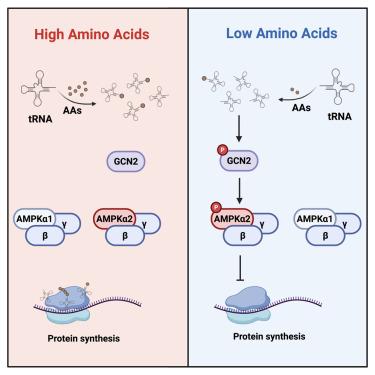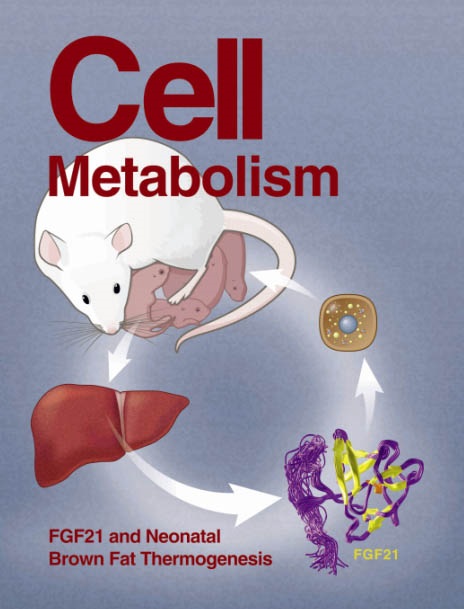AMPKα2信号氨基酸不足,抑制蛋白质合成
IF 30.9
1区 生物学
Q1 CELL BIOLOGY
引用次数: 0
摘要
amp活化蛋白激酶(AMPK)复合物的两个催化亚基α1和α2之间的功能差异尚不清楚。在此,我们报道了AMPKα2特异性地将氨基酸不足信号转导到蛋白质合成。在来自100万中国个体的阿尔茨海默病(AD)患者的血液样本中观察到低氨基酸水平、高蛋白质水平和AMPKα苏氨酸172 (p-T172)磷酸化降低。α2的缺失,而α1的缺失,再现了这些观察结果,并在小鼠中诱导ad样认知功能障碍。机制上,低氨基酸激活的一般控制非抑制2 (GCN2)特异性磷酸化α2的T172位点,不依赖于AMP和果糖1,6-二磷酸,以抑制蛋白质合成。α2-p-T172缺失导致细胞和小鼠脑内蛋白过度合成和ad病理性蛋白聚集。AMPK激活剂二甲双胍和5-氨基咪唑-4-羧酰胺-1- β -d -核呋喃苷(AICAR),以及支链氨基酸(BCAA)或蛋白质限制性α2-p- t172依赖于预防小鼠ad样症状。我们发现AMPKα2是蛋白质合成的特异性氨基酸丰度检测器。本文章由计算机程序翻译,如有差异,请以英文原文为准。

AMPKα2 signals amino acid insufficiency to inhibit protein synthesis
The functional difference between the two catalytic subunits, α1 and α2, of AMP-activated protein kinase (AMPK) complexes remains elusive. Herein, we report that AMPKα2 specifically transduces amino acid insufficiency signals to protein synthesis. Low amino acid levels, high protein levels, and reduced phosphorylation of AMPKα threonine 172 (p-T172) are observed in blood samples in patients with Alzheimer’s disease (AD) from a cohort of 1,000,000 Chinese individuals. Loss of α2, but not α1, recaptures these observations and induces AD-like cognitive dysfunction in mice. Mechanistically, low amino acid-activated general control nonderepressible 2 (GCN2) specifically phosphorylates α2 at T172 independent of AMP and fructose 1,6-bisphosphate to inhibit protein synthesis. α2-p-T172 loss renders protein over-synthesis and AD-pathologic protein aggregation in cells and in mouse brain. AMPK activators metformin and 5-aminoimidazole-4-carboxamide-1-beta-D-ribofuranoside (AICAR), as well as branched-chain amino acid (BCAA) or protein restriction, α2-p-T172-dependently prevent AD-like symptoms in mice. We identify AMPKα2 as a specific amino acid abundance detector for protein synthesis.
求助全文
通过发布文献求助,成功后即可免费获取论文全文。
去求助
来源期刊

Cell metabolism
生物-内分泌学与代谢
CiteScore
48.60
自引率
1.40%
发文量
173
审稿时长
2.5 months
期刊介绍:
Cell Metabolism is a top research journal established in 2005 that focuses on publishing original and impactful papers in the field of metabolic research.It covers a wide range of topics including diabetes, obesity, cardiovascular biology, aging and stress responses, circadian biology, and many others.
Cell Metabolism aims to contribute to the advancement of metabolic research by providing a platform for the publication and dissemination of high-quality research and thought-provoking articles.
 求助内容:
求助内容: 应助结果提醒方式:
应助结果提醒方式:


